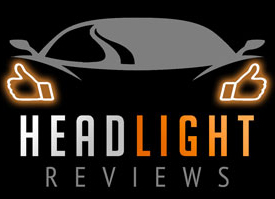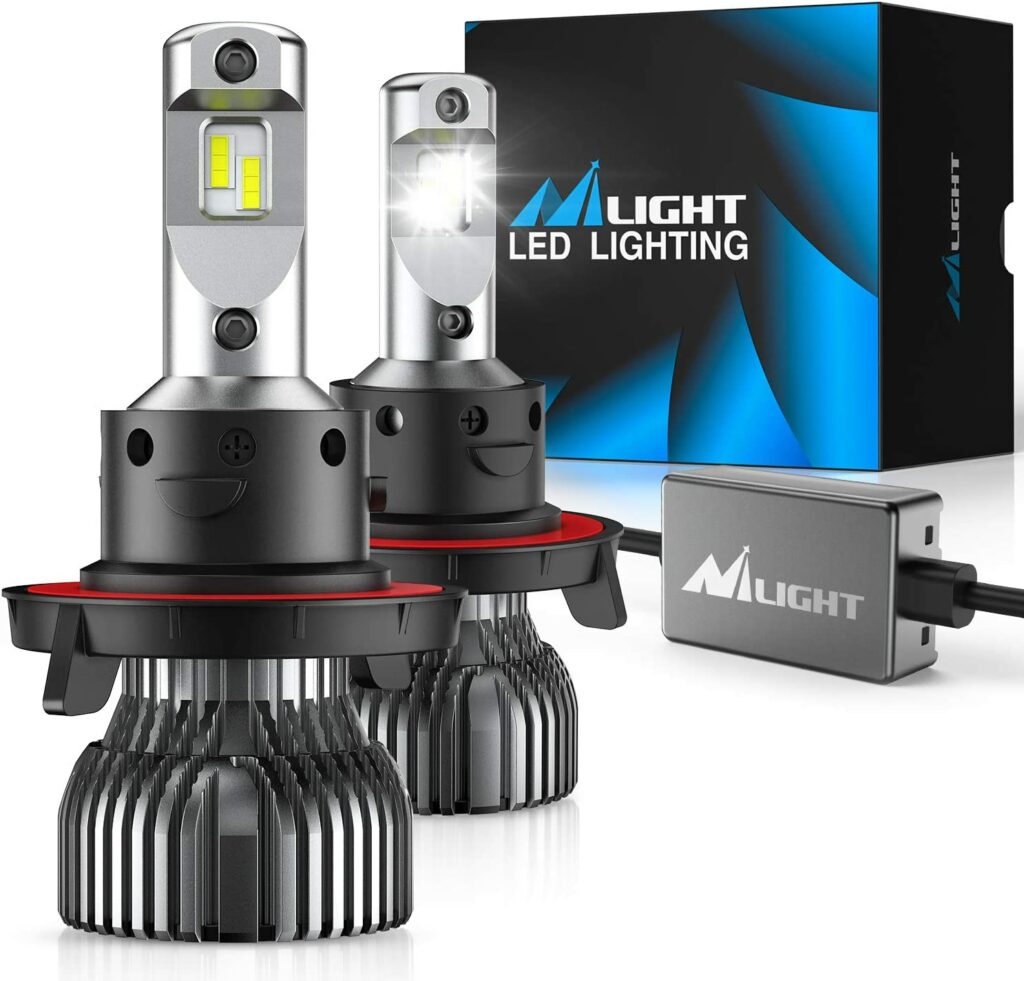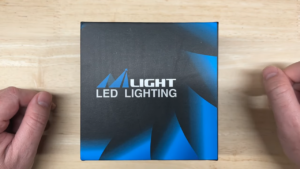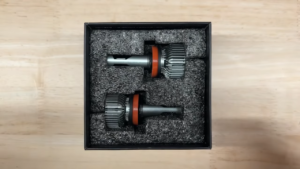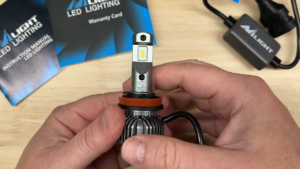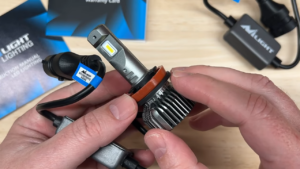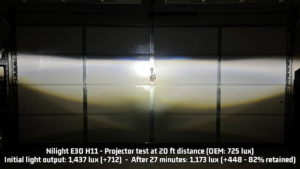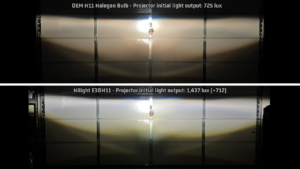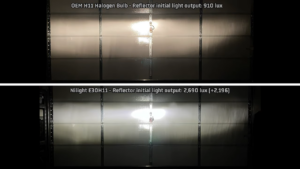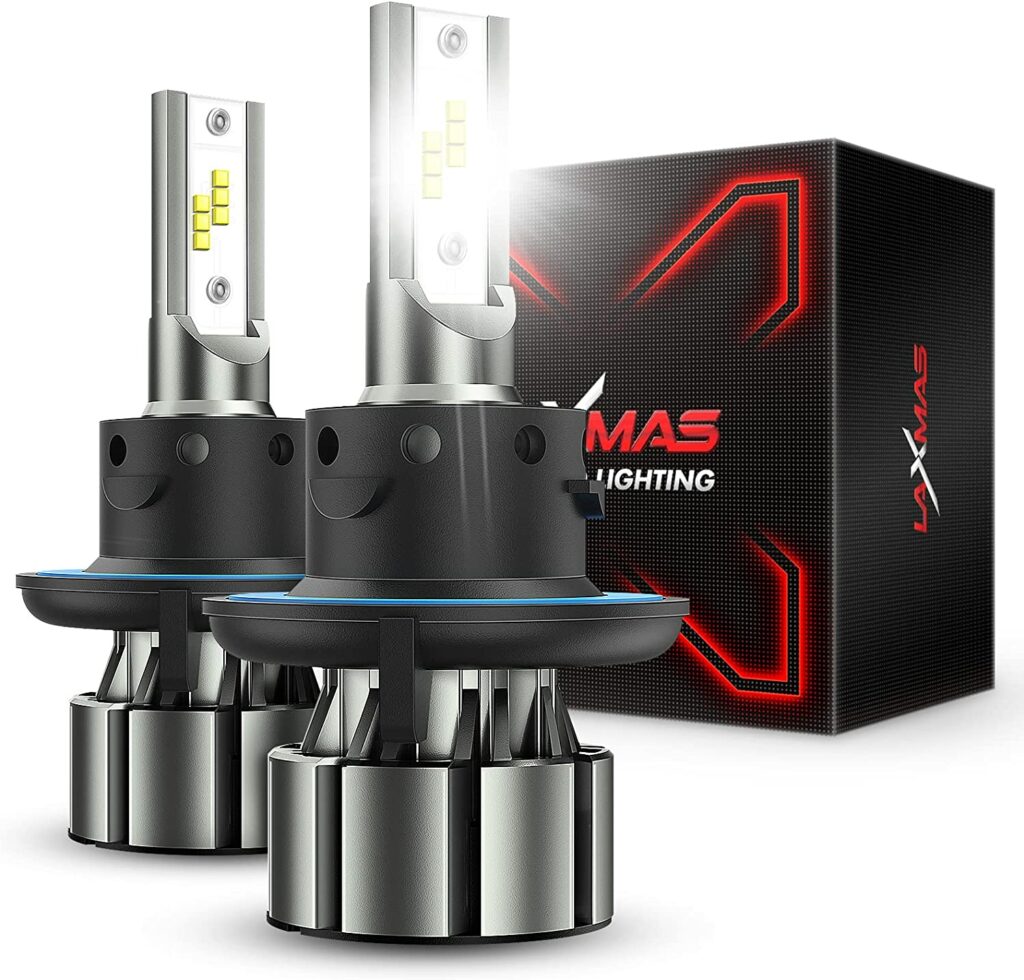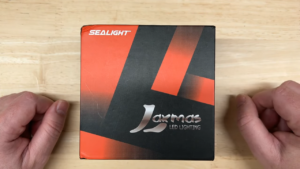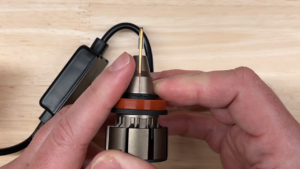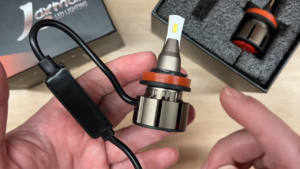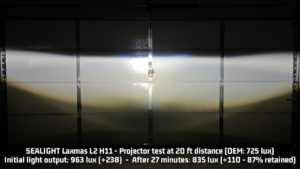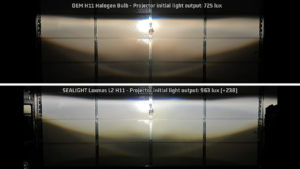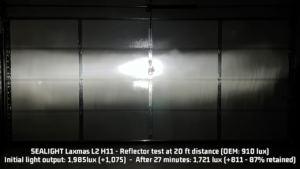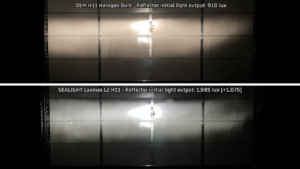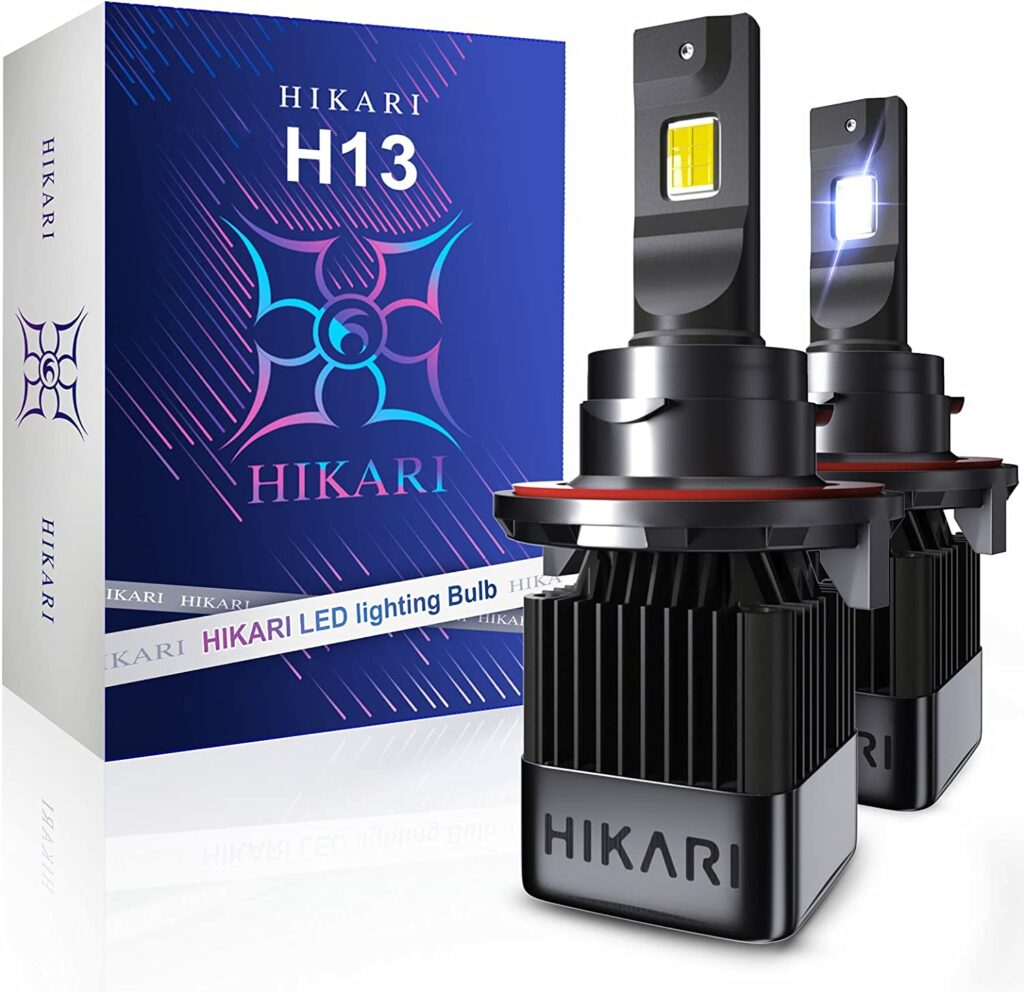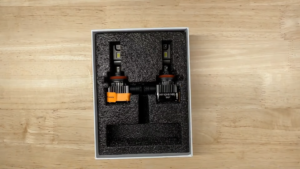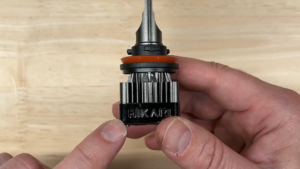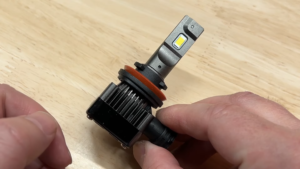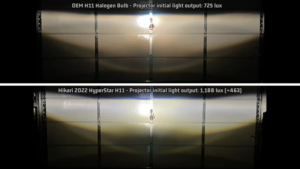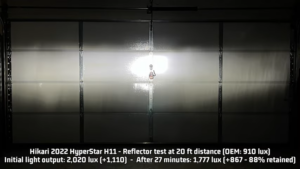This is my buying guide on the best LED headlight bulbs for the Ford F250 in 2025. Below is a quick summary of my top recommendations. Scroll further down to read my in depth, hands on reviews for each headlight brand.
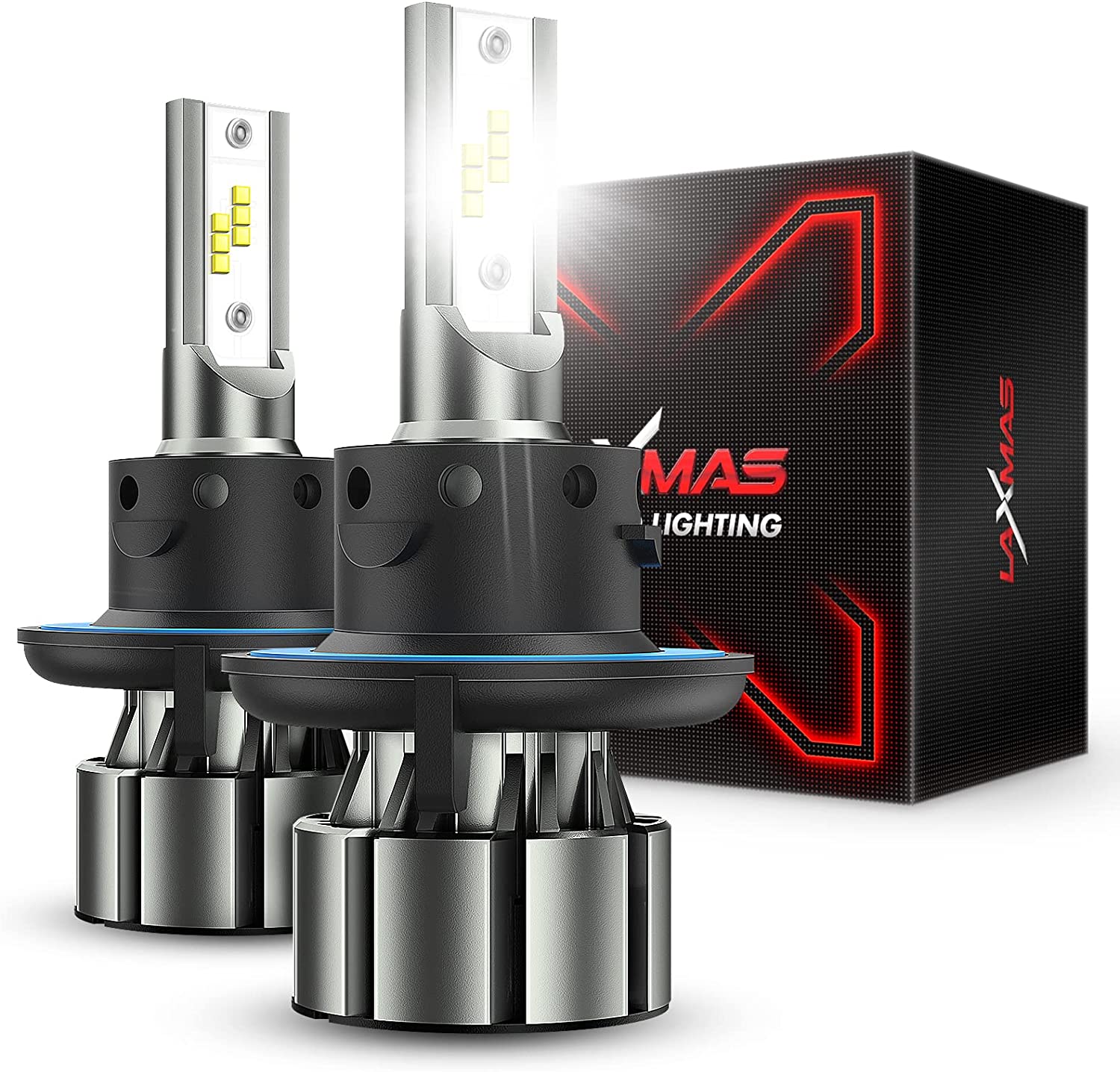
Laxmas H13 LED
Headlight Bulbs
- Plug and play
- 18,000 lumens/set
- Extended beam pattern
- 6,500K Cool White
- +500% brighter than halogens (advertised)
- Runner-up for best overall H13 LEDs
- 50,000-hour lifespan
- 60W per set
- All-in-one unit with built-in driver
- Built-in 13,000 RPM turbo cooling fan
- Excellent heat-retention 87%
- Low temperature of 117° after 27 minutes
- IP67 Water resistant
- 1-year warranty
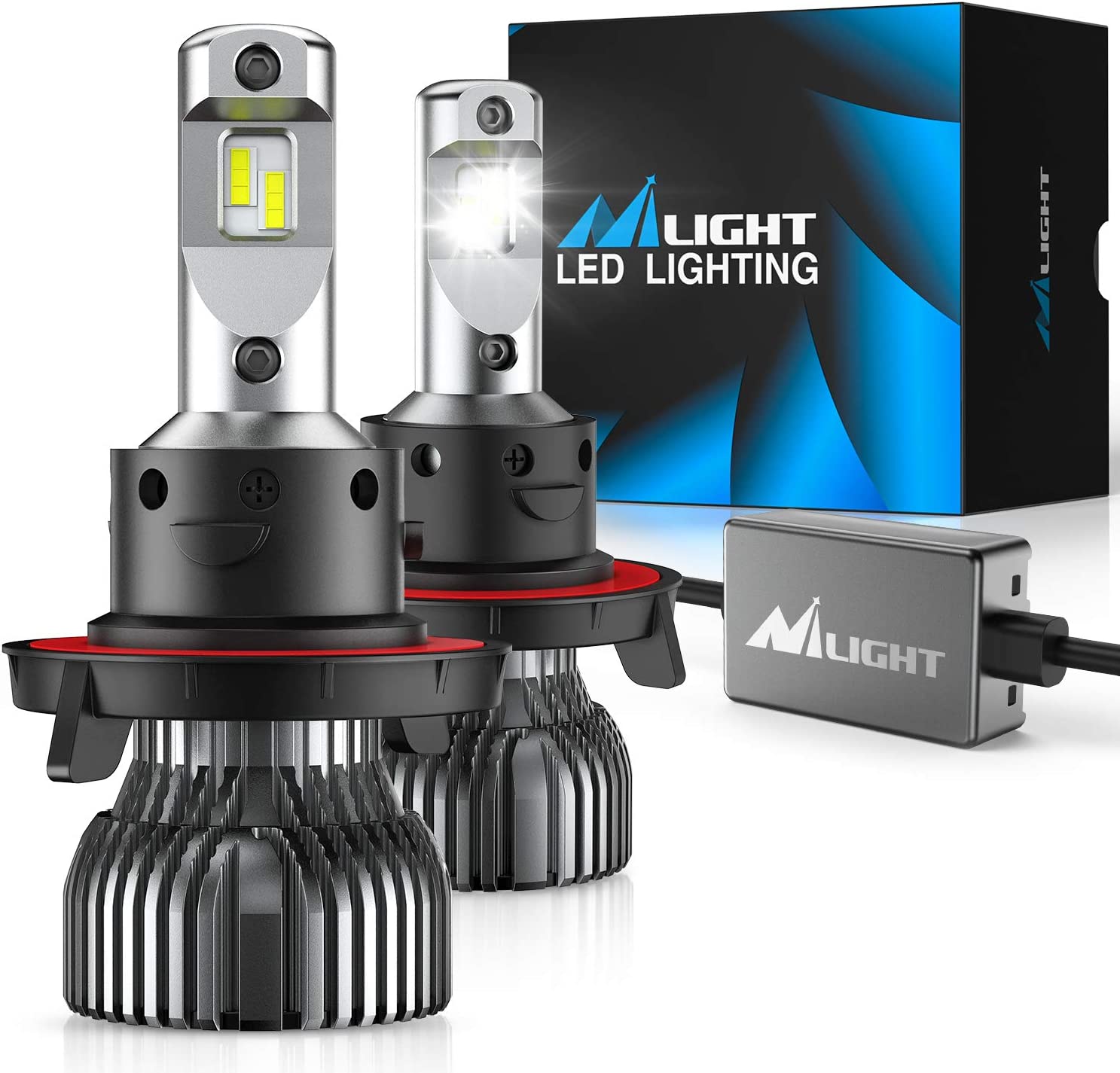
Nilight H13 LED
Headlight Bulbs
- Plug and play
- 9,000 lumens/set
- 6,500K Cool White
- +500% brighter than halogens (advertised)
- Thin 0.04-inch emitter board
- Best overall H13 LEDs
- Well-controlled beam pattern
- 50,000-hour lifespan
- 70W per set
- External driver
- Built-in 12,000 RPM turbo cooling fan
- Excellent heat retention 82%
- IP67 Water resistant
- 2-year warranty
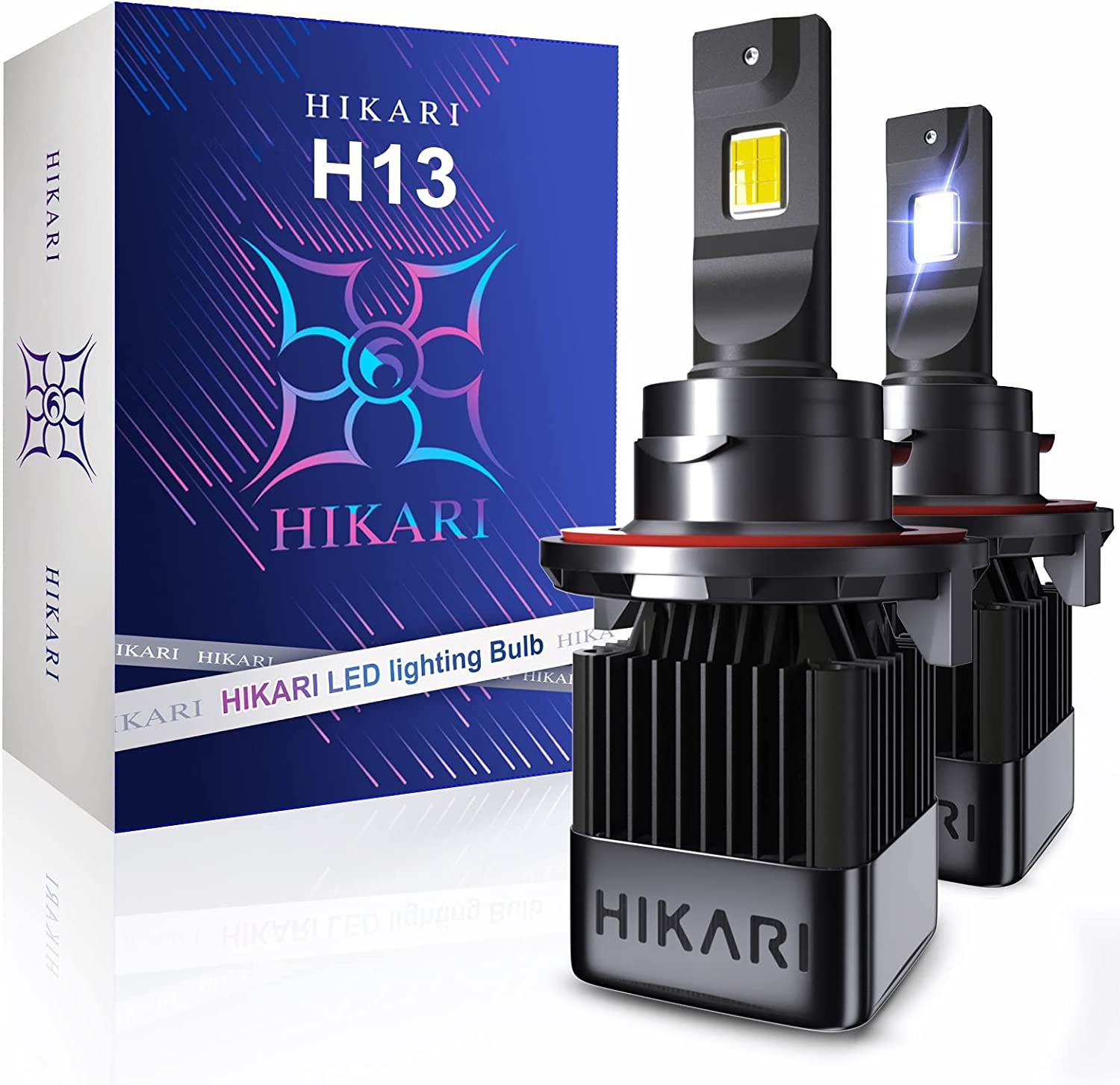
Hikari Hyperstar H13
LED Headlight Bulbs
- Plug and play
- 20,000 lumens/set
- 6,000K Cool White
- +400% brighter than halogens (advertised)
- Best premium H13 LEDs
- 50,000-hour lifespan
- 64W per set
- All-in-one unit with built-in driver
- Built-in 15,000 RPM turbo cooling fan
- Heat retention of 87%
- Very cool after 27 minutes at 122°
- IP68 Water resistant
- 2-year warranty
The Ford F series have been the best-selling trucks in the US for 46 consecutive years.
And the Ford 250 is an extremely popular model; as such, it’s easy to buy replacement headlight bulbs, but not that easy to know which ones to purchase.
I’ve been testing headlight bulbs for over a decade and know what bulbs are the best and which aren’t.
The Ford F250 has various makes and models, but the most commonly used headlight bulb is the H13. I recommend that once the stock halogens burn out, they get replaced with LEDs.
LEDs are brighter and whiter and last longer. You can read more in the FAQs below.
So which H13 LEDs are best for a Ford F250? I’m glad you asked.
My pick for best overall is the Nilight H13 LED headlight bulb. These are bright, have excellent heat retention, and are a perfect fit for the Ford F250.
I’ll also review a runner-up for best and a premium option for those with a higher budget.
Important note: I don’t own an F250 (though I wish I did), but I borrowed my buddy’s one so I could see how all the bulbs worked. My experiences are detailed below.
The Fine Print
Nilight pitches their H13 LED headlight bulbs at 9,000 lumens per set, admittedly lower than some, yet still a massive step up from the average 1,000 lumens most stock bulbs provide.
They boast about being 500% brighter than stock, a claim that I’m a tad skeptical about. My testing below will shed some light on this matter.
The Nilight H13 LEDs claim to cast light as far as 900 feet, offering strong penetrability and doubling the view range of stock bulbs.
One of the key reasons I tend to favor LEDs over stock bulbs is the Kelvin color. Factory halogens usually have a Kelvin color around 3,000, giving off that amber/yellow light.
To clearly see objects ahead of me, I prefer a crisp white light, ideally somewhere above 6,000K. The Nilight H13 LEDs hit the mark at 6,500K, making them an ideal fit for the Ford F250.
The main unit of the bulb is crafted from aircraft-grade aluminum and houses a built-in 12,000 RPM turbofan.
Given such advanced cooling and a mere 70 watts of power drawn per set, I’d anticipate these bulbs won’t be prone to overheating. But let’s see what my testing says.
Nilight guarantees a 2-year warranty for its H13 LED headlight bulbs and suggests a lifespan of 50,000 hours. While I haven’t seen a bulb last this long, the warranty boosts my confidence in its longevity.
Sporting an IP67 rating, these bulbs can withstand a range of weather conditions, from snow to thick fog and heavy rain, without compromising performance.
In My Hands
Opening the box, I was greeted with a pleasant surprise. Nilight goes the extra mile for its customers. The first thing I came across was a pair of anti-static gloves – a fantastic inclusion to ensure safety during installation.
Additionally, zip ties and double-sided tape were included to secure the external driver in place.
A generic manual was also part of the package, but these bulbs are plug-and-play, presenting no installation problems. They’re designed 1:1 against stock bulbs, so they slipped right into place for me.
The Nilight H13 LED bulbs are a sight to behold. With a top-notch construction and an all-metal build, they feel high-quality to the touch.
I’m quite taken by the sleek silver coating, and the inverted, removable collar adds a distinctive touch exclusive to Nilight.
One feature I particularly appreciate is the thin copper board the chips mount onto – a slim 0.04 inches. If it serves the purpose I’m anticipating, I’ll be mighty impressed.
The Test Run
I follow a consistent testing procedure for all headlight bulbs, positioning my LED meter 20 feet from the bulb.
I’ll be comparing these bulbs against stock halogens, which typically register a lux rating of 725 in the projector test and 910 lux in the reflector test.
So how does the Nilight H13 LED Bulbs stack up? Quite impressively, I must say!
In the projector test, I clocked an initial reading of 1,437 lux – twice the brightness of the stock bulb.
Then, I took a reading after 27 minutes, the average commute time in the US. This figure indicates heat retention, and I was thrilled to see it held steady at 82%, or 1,173 lux.
For the reflector test, the initial reading was 2,690 lux, almost three times brighter than stock. While it falls short of the claimed 500%, it’s nonetheless a substantial improvement, retaining 82% at 2,176 lux.
Given the thin emitter board, I was expecting a near-perfect beam pattern, and it didn’t disappoint.
There was a hint of blur at the cutoff and a slight weakness in the lower middle and bottom left of the beam. Otherwise, the beam was impressively well-controlled.
The advertised watts seem off to me. Nilight states 35 watts per bulb, yet my readings showed just 24.8 watts. The silver lining here is that they’re even more power-efficient.
This was reflected in the temperature too. After 27 minutes, the main unit recorded 129°F and the driver 136°F.
From the Driver’s Seat
Nilight H13 LED headlight bulbs are highly acclaimed by other drivers, earning an overall rating of 4.5/5 stars.
Customers are thrilled with the brightness and the simplicity of installation. I echo these sentiments.
A few vehicles reported flickering, an issue that a decoder can rectify. While I didn’t encounter this issue with my buddy’s Ford F250, a few drivers did face initial hiccups.
In a Nutshell
For the Ford F250, my top recommendation would be the Nilight H13 LED headlight bulbs. With their brightness, excellent heat retention, and well-controlled beam pattern, these bulbs are the perfect match for the Ford F250.
Pros
- Plug and play
- 9,000 lumens/set
- 6,500K Cool White
- +500% brighter than halogens (advertised)
- Thin 0.04-inch emitter board
- Best overall H13 LEDs
- Well-controlled beam pattern
- 50,000-hour lifespan
- 70W per set
- External driver
- Built-in 12,000 RPM turbo cooling fan
- Excellent heat retention 82%
- IP67 Water resistant
- 2-year warranty
Close Second
A very close competitor for the best H13 bulbs for the Ford F250 is the Laxmas H13 LED headlight bulbs.
The Spec Sheet
What stands out about the Laxmas H13 LED headlight bulbs is their advertised brightness – a whopping 18,000 lumens per set, which is twice as bright as Nilight’s, and yet, like Nilight, they claim to be 500% brighter than stock bulbs.
Equipped with a smart CSP LED chip, these bulbs are designed to cast a broader, farther-reaching light. And, having tested them on an F250, I can vouch for their wider beam when compared to the stock F250 bulbs.
Their 6,500 Kelvin color white makes spotting obstacles and traffic signs easier and quicker than when using stock bulbs.
The most notable difference between the Laxmas and Nilight is the all-in-one design of the former, including a built-in driver. Does this change make a difference? Well, you’re about to find out from my test results.
Installing these bulbs in my buddy’s Ford F250 was a breeze. They come with a non-polarity socket and a 360° adjustable mounting bracket. I was done within five minutes for each bulb.
Their cooling system sounds impressive – a 6063 aluminum alloy shell with eight heat dissipation ducts and an ultra-thin heat sink, topped off with a 13,000 RPM turbofan.
Drawing only 60 watts of power per set, Laxmas suggests a lifespan of 50,000 hours, but with only a 1-year warranty. This gives me pause about their durability.
Just like Nilight, these bulbs boast an IP67 waterproof rating, meaning they’re all set to brave any kind of weather.
What I Found
Inside the box, there’s a detailed manual. However, given how straightforward the installation was, I didn’t need to consult it.
I was puzzled by the inclusion of zip ties and double-sided tape since there’s no external driver to deal with.
The Laxmas H13 LED bulbs are compact and identical in size to stock bulbs, which probably explains their easy installation.
While they are nicely designed and emit a lovely light, there’s nothing striking about their appearance.
Test Drive
Despite the boasted high lumens, I only recorded an initial rating of 963 lux in the projector test. This is just about 150% brighter than stock.
After 27 minutes, however, the brightness only dropped to 835 lux, retaining 87% of its initial brightness. That’s exceptional heat retention, surpassing the average by more than 10%.
In the reflector test, the initial reading was 1,985 lux, which is 210% of what stock bulbs would provide, and it retained 87% of this, recording 1,721 lux after some time.
The beam pattern of these bulbs is impressive – far superior to the stock ones. They have a sharp cutoff and only slight weakness in the center bottom, but the lighting is even on both sides.
The power draw I noted was 25.9 watts, noticeably lower than the advertised 30 watts, which is excellent for power efficiency, as evidenced by the recorded temperature.
Their robust cooling technology has proven effective; after 2 minutes, I registered just 117°F.
Driver Feedback
Other drivers have also shown favor for the Laxmas H13 LED headlight bulbs, rating them at 4.5/5.
Drivers particularly appreciate the clarity provided by the white light and the impressive length of the beam.
As with the Nilight bulbs, some drivers have reported CAN bus flickering errors that were resolved using a decoder.
Wrap Up
The Laxmas H13 LED headlight bulbs are definitely a strong contender for the top H13 LED headlight bulbs. The only thing that makes them fall slightly behind the Nilight’s is that they’re not quite as bright.
Pros
- Plug and play
- 18,000 lumens/set
- Extended beam pattern
- 6,500K Cool White
- +500% brighter than halogens (advertised)
- Runner-up for best overall H13 LEDs
- 50,000-hour lifespan
- 60W per set
- All-in-one unit with built-in driver
- Built-in 13,000 RPM turbo cooling fan
- Excellent heat-retention 87%
- Low temperature of 117° after 27 minutes
- IP67 Water resistant
- 1-year warranty
Deluxe Choice
If you’re someone who, like me, leans towards the more high-end options for your Ford F250, then you ought to consider the Hikari Hyperstar H13 LED headlight bulbs.
What They’re Selling
Headlight bulb marketing seems to be playing the numbers game, with increasingly larger claims that don’t necessarily hold up.
Take, for instance, Nilights have 9,000 lumens, Laxmas boasts 18,000 lumens, both asserting they’re 500% brighter. Then here we have the Hikari Hyperstar H13 LED bulbs, claiming a chart-topping 20,000 lumens, but only 400% brightness.
Curious, isn’t it? I took these out for a spin to see how their actual brightness measures up against stock halogens.
The Hikari Hyperstar H13s color temperature is slightly lower at 6,000K, compared to Nilight and Laxmas. Still, I must say, I was impressed by the clarity with which I could see objects and how much farther down the road I could spot street signs.
The bulb uses what’s referred to as an Acme X chip, which seems to be unique to them as I haven’t encountered it in any other bulb.
Much like the Laxmas, the Hikari Hyperstar H13s is an all-in-one model, complete with a built-in internal driver. I’m predicting we’ll be seeing a lot more of this in the future.
They’re said to draw a peculiar 64 watts per set.
The Hikari Hyperstar H13 LEDs boast an advanced cooling system equipped with a whopping 15,000 RPM turbofan. That’s the highest RPM I’ve ever heard of in an LED headlight bulb. Does it deliver on its promise? You’ll find out in a bit.
Promising a life span of 50,000 hours, similar to Nilight, these bulbs come with a 2-year warranty.
Setting itself apart from Laxmas and Nilight, the Hikari Hyperstar raises the bar with a waterproof rating of IP68. From top to bottom, the Hikari screams premium.
In the Field
The box holds a detailed manual with some FAQs and, of course, the bulbs. Nothing more.
With technology advancing rapidly, the all-in-one design seems to be catching on. And I can see why. The absence of an external driver simplifies the installation process, and I found this to be true with the Hikari. They estimate a five-minute installation, and I’d say that’s about right.
The Hikari Hyperstar H13 LEDs are a sight to behold. Made from high-quality materials, their robust square design is appealing. They feel sturdy to the touch, and the heat sink is well-crafted.
I particularly liked the black chrome finish and the subtle touches like the engraved Hikari name at the bottom and its logo on the fan cover.
However, a couple of things caught my eye that I didn’t quite fancy.
The LED chips have unusually wide emitters, which left me a bit worried about the extended beam.
I also wasn’t too keen on the friction-fit adjustable collar. I prefer ones that clip in, but would this affect its performance? We’ll see.
The DOT stamp at the base of the unit didn’t sit well with me either. The DOT isn’t an approving entity; that’s not what it does. This stamp could be potentially misleading.
Behind the Wheel
With 20,000 lumens in their marketing material, I was expecting the bulbs to be blindingly bright. Unfortunately, they fell short.
In the projector test, the initial rating clocked in at only 1,188 lux, 453 lux above stock halogens, making them 160% brighter.
What did impress me was that, even after 27 minutes, they managed to retain 1,045 lux. That’s 88% of their initial brightness – outstanding heat retention.
The reflector test yielded an initial rating of 2,020 lux, which is 220% brighter than halogens, but nowhere near the claimed 400%.
Despite the excellent heat retention, dropping only to 1,777 lux after 27 minutes, the high cut-off resulting from the wide emitters meant I couldn’t see as far down the road as I could with the Laxmas and Nilight.
While the beam pattern was decently controlled, it seemed a bit wavy at the cutoff area due to those wide emitters.
As for the power draw, I registered 30.4 watts, justifying their advertised rate of 32 watts each.
But here’s what I absolutely loved about the Hikari Hyperstar H13 LED bulbs.
The fan doesn’t just go on or off abruptly. Instead, it gradually ramps up over time, contributing to the effective heat control.
This showed up in my temperature reading as well. After 27 minutes, the temperature stood at a relatively cool 122°F, quite impressive, especially for an all-in-one unit.
The Word on the Street
Other drivers seem to agree that the Hikari Hyperstar H13 LED is a fantastic premium bulb, with a 76% of them giving it a perfect score.
Customers have claimed these as their favorite headlight bulbs, citing their brightness, reliability, and durability.
Several of them did raise the issue of limited distance projection, making me wonder if Hikari will reconsider using such wide chips in their future models.
Wrapping Up
While the Hikari Hyperstar H13 LED headlight bulbs might not shine as bright as the Nilight or Laxmas, they more than make up for it with their solid construction, excellent heat management, and cool operation. They indeed make for a high-quality choice.
Pros
- Plug and play
- 20,000 lumens/set
- 6,000K Cool White
- +400% brighter than halogens (advertised)
- Best premium H13 LEDs
- 50,000-hour lifespan
- 64W per set
- All-in-one unit with built-in driver
- Built-in 15,000 RPM turbo cooling fan
- Heat retention of 87%
- Very cool after 27 minutes at 122°
- IP68 Water resistant
- 2-year warranty
Cons
- CAN bus errors in some vehicles
LED Headlight Bulbs Ford F250 FAQ
What headlight bulb sizes does the Ford F250 use?
Most Ford F250 vehicles require an H13 bulb for high and low beams. There are some exceptions. For example, some 2020 models use an H13 for high but an H7 for low.
Then there are the special vehicles with LH Asymmetry that need a 9005 for high beam and an H7 for low beam.
Before buying replacement headlights, always check which ones your Ford F250 make and year requires.
Any other headlight upgrades I should consider for the Ford F250?
Yes! I recommend upgrading from stock halogen H13s to LEDs if you have a Ford F250. Why? They provide more clarity.
Safety when driving is paramount. I like to see objects in front and off to the side as quickly and clearly as possible. I don’t think the 3,000 Kelvin color of stock halogens give me that.
The 6,000+ Kelvins of LEDs do. All the bulbs I’ve compared against stock ones provide better clarity every time.
Is a CAN bus Converter needed for LED bulbs on my Ford F250?
Some Ford F250 drivers reported needing a CAN bus converter, while others didn’t. I had no problem with the Laxmas, Nilight, or Hikari H13 LED bulbs.
Think of it like a surge protector. It evens out the draw of power, which causes flickering or dashboard errors.
Are LED Headlight bulbs worth it for the Ford F250?
For me upgrading to LEDs for the Ford F250 is much more cost-effective. Stock halogens burn out very quickly, and LED bulbs have advanced technology and cooling systems that create better heat management and much longer life.
I’ve never had to replace LEDs as often as stock bulbs, saving me lots of money in the long run.
